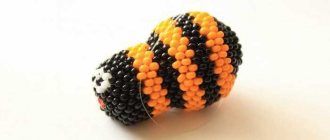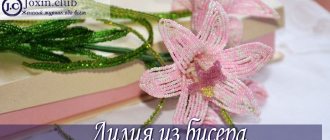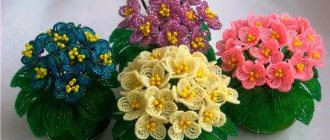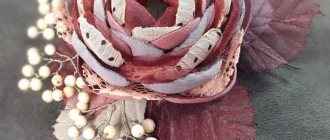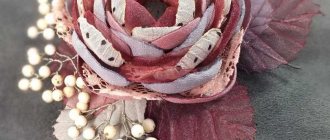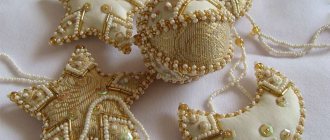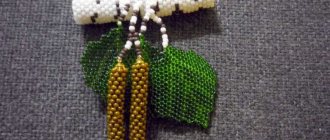Tools and materials
Experienced needlewomen determine by eye how many beads will be needed for each flower, but beginners need clear instructions.
Standard list of things needed for making flowers:
- beads;
- fishing line;
- wire;
- fabrics and threads;
- sequins and other decorations;
- needles;
- scissors and/or wire cutters.
You can string beads on wire or fishing line. If the flower needs to be stable, craftswomen usually use strong copper wire. A flower bud is rarely complete without a stem. If not wire, then a skewer or toothpick can do the job. The element is masked with thread of a suitable color or wrapped in fabric.
For more information about materials and tools, read the article: “Materials and tools for beading: beads, needles, threads, accessories, how to choose and use.”
Floral tape, designer paper, artistic tape - all this can also be used in floral design. The size of the beads is different. Usually needlewomen take medium-sized beads, small ones. But large beads do not look entirely organic in beadwork of flowers and bouquets. The description of a flower may be complex, but the basis is precisely beads, fishing line or wire, an additional simple material for decoration. Everything else depends on the imagination of the craftswoman.
What you need for beading
- Beads of the required color and size.
- Copper wire of various lengths and thicknesses.
- Scissors.
- Velvet napkin (to prevent beads from scattering on the table).
- Containers for beads of different colors.
- Masking tape or yarn (for branches and trunk).
- Flower pot.
- Soil, sand or gypsum mortar.
Fluffy cactus with beaded flowers
A very beautiful cactus and lifelike. It can be a good addition to the interior of your room, place it near your computer for beauty, it will definitely lift your spirits! And yes, it doesn’t need to be watered...at all, even once a year
Let's start with the basics
In order to make a base for a cactus, you need to find a piece of foam plastic or buy a ball or egg shape from a craft store, since they are the most common and you can shape the cactus yourself. Use a regular stationery knife to cut off any excess. Now you can paint the finished base with green paints. Anything you have at home will do.
Now we weave thorns
The spines consist of wire 0.3 mm in diameter and green beads No. 10. Place 10 beads on the wire, close it in a ring, pass the second ring through 5 beads and tighten. You will get an oval ring. Leave one end of the wire about 1 cm, and the other about 4 cm. Make 2 more such rings and twist them together. Here you have the main fragment of a cactus spine. Now weave an even larger bunch of exactly the same ones and carefully stick them one by one into the foam base.
Making flowers
The flowers consist of wire 0.3 mm in diameter and yellow or pink beads No. 10. Each flower consists of loops gathered into a bunch. The size of the loops can be different, it all depends on your desire and planned design. In the example, the flowers are different; a real cactus has even larger flowers, so use your imagination.
On average, a large flower can consist of twenty loops, and a small flower can consist of 10-12 pieces. I showed an example of production above using visual photos. This is a very simple process and I think you can do it with ease. All the elements of a cactus are very simple, but there are many of them and that’s why the work is painstaking. However, the more work you put into your work, the more you value the result. So I wish you all good luck and lots and lots of patience!
Master class on rowan beading
“The technique is somewhat more complex than beading a bonsai tree, so beginners can spend quite a lot of time making the required 187 green pieces.”
Looking at the finished works, sometimes it seems that weaving a Dionysus tree or a rowan tree from beads is extremely difficult. However, in practice everything is not so scary. Even beginners can take on such a project. This is truly an exciting and exciting event. The masterpiece that comes out of your hands can turn out to be more than realistic if you are not too lazy to strictly adhere to the recommendations of the masters.
Let's look at the sequence of the process using the example of creating an impressively beautiful rowan tree.
What to cook
- 1. Beads in two shades: orange-red and green. You can take material made in Czech or Chinese. In the first case, the size of the beads is No. 10, in the second – No. 12.
- 2. Wire with a cross section of 0.3 mm and thick, which will be needed for the barrel.
- 3. Thread or masking tape for wrapping branches.
- 4. Brown paint.
- 5. Alabaster.
- 6. Varnish.
Work on a beaded rowan tree begins with weaving its clusters. This is a prefabricated element. To form it you need to prepare five small bunches of berries.
This is done as follows.
- We cut 33 cm from a coil of thin wire and collect 3 orange-red bugles per piece.
- Move them 5 cm from the edge of the wire and twist the loop.
- The length of the twist on the wire is 1 cm.
- We collect 3 beads again and repeat the manipulation.
- In total, 10 such elements should appear on the wire segment.
- The next step is to collect all the “berries” into a bundle by twisting the wire ends. We make 4 more similar blanks and form a bunch. For a small tree we need 11 full bunches.
- The second stage will be the creation of the deciduous part of the crown. Here we will use a parallel beading technique. To work, you will need a piece of wire 25 cm long. We will string a green bead onto it and place it in the center.
- Now let's take the end of the wire (which one does not matter) and thread it into the same bead, but in the opposite direction. Let's tighten the knot. Next, we put two beads on the wire and repeat the procedure with the return of the wire. Tighten the ends, firmly fixing the new row.
In the third row there will already be three bugles. We repeat the steps for passing the wire back.
- In the same spirit we weave the next two rows.
- But starting from the sixth row, the leaf will begin to decrease, so not three, but only two beads will fall on the wire, and in the seventh, respectively, one.
- The remaining free wire ends are twisted.
When everything is ready, we will form an original rowan leaf from single elements.
- First, we will twist three leaves together, then we will wind a pair of parallel parts onto the resulting rod.
- The step distance between pairs is 0.5 cm. There will be three such pairs in total.
Wood assembly
The most critical stage . Here you will have to think about how to assemble the branches into a single whole in order to get a beautiful crown. You may have to disassemble the craft more than once and redo it again.
There's nothing wrong with that.
In bead weaving, trees rarely turn out perfect the first time, even by professionals, so shape the crown as much as you see fit, that is, until you are satisfied with what you see.
To collect the crown, you need to prepare branches. To do this, we connect a bunch and a large leaf in pairs. Below along the wire we attach the next leaf and bunch. We repeat the procedure again. The first crown branch is ready.
Having assembled the remaining pieces according to this principle, we begin to assemble the composition.
- Now a thick wire will go to work, to one end of which a branch will be attached.
- This will be the center around which the crown will form.
- Fix subsequent branches at a certain distance from each other, bending in the appropriate direction.
- For strength, wrap the elements well with tape or plaster.
- The latter should be fabric or paper.
Now let's make a stand. Let's dilute plaster or alabaster to the consistency of sour cream and pour the solution into a suitable container. Let's lower the wire bottom of the tree into it and let it harden.
Next are some tips on how to properly plaster wood from beads for beginners.
It will not be possible to add volume to the trunk by pouring the compound, so we will use small, 10 centimeter pieces of wide bandage. This is what we will impregnate with plaster and wrap it around the wire in the stem part. Most likely, you will have to do this several times.
Here you need to focus on the adequacy of the height of the tree with the width of the trunk.
Next, we coat all the branches with gypsum solution, after covering the decorative part with cling film. Let it dry thoroughly and paint it brown. You can use acrylic, oil or gouache paints.
The finishing touch will be the varnishing of the wood part of the composition and the design of the stand.
Specifics of selecting compositions for the style of celebration
Every bride should know these rules:
the bouquet should complement the dress, and not compete with it. A lush dress, richly decorated with beads, should be complemented by a modest bouquet. Conversely, a formal dress can be complemented with a bouquet of large mother-of-pearl beads; carefully select the shape of the bouquet
Ask the florist to show you all the options, even the most incredible ones; Pay special attention to the handle of the bouquet. Braid it with satin ribbons in the color of the overall holiday color
Make sure the handle is not too big; The aroma of flowers is an important component of the entire bouquet. You can drop a drop of your favorite perfume on artificial flowers.
Also, to create a style, it is important to know the trends of 2022:
- small bouquet;
- coral shades;
- ombre effect;
- garden style;
- ears of corn and grass;
- mono bouquets;
- one color accent.
All this can be realized with the help of beads and beads.
Tulips with mosaic weaving
To imitate dense wide tulip petals, circular weaving is not suitable, it is too airy. It is better to make petals using the mosaic technique. When learning beading for the first time, patterns are a must.
Note!
- Drawing master class: step-by-step do-it-yourself drawing schemes. Master classes on creating drawings using different techniques (120 photos)
- Master class on sculpting - TOP 150 photos with step-by-step instructions on sculpting products with your own hands. Master classes for beginners
- Sewing master class - TOP 150 photos with detailed DIY sewing master classes. The basics of sewing from experienced craftsmen
How to achieve a good flower appearance
Before you begin, carefully read the description of the model manufacturing process, think over the color scheme of the product (it may be the same as the one proposed or differ from it) and select the appropriate material. It is not necessary to choose beads of the specified number - sometimes using a different material leads to very interesting and unexpected results.
It is very convenient to use special colored wire for making flower arrangements, which can be purchased in flower shops or in specialized departments that sell everything necessary for needlework. This wire comes in white, gold, red, green, dark green and other colors. If it is not possible to purchase special colored wire, you can use ordinary copper or steel wire, which is used in various electrical appliances in the form of transformer windings or filling insulated wires.
Beads are a fairly heavy material, and some complex or large products made from it turn out to be quite heavy. Therefore, sometimes to strengthen the stems of flowers they use a special floral wire with a diameter of 0.6-1.2 mm - it is sold in flower shops in the form of bundles of pieces 0.25-0.40 m long. Having a small diameter, such wire is elastic enough to give the flower the desired shape.
It may happen that while working on the product the wire breaks. If this happened at the beginning of the work, it is easier to start executing the element again. If a significant part of it has been completed, it is necessary to release the torn end, unraveling the last few rows, and secure it using one of the methods proposed below.
The first way is to pass each end of the wire back along the product (Fig. 1 a), repeating the weaving principle. This is only possible if the wire passes through the bead hole several times. If the beads are too small or the wire is thick, they resort to the second method: the ends of the wire are carefully passed through the loops between the rows along the edge of the product (Fig. 1b). If, during the description of the models, you come across indications of the need to close the ends of the wire, you can use any of the proposed methods.
Sometimes, to give a product the desired shape, it is necessary to fasten several elements together. To do this, an additional wire of the required length is cut, one end is threaded into the loop between the rows along the edge of the first element, and the other passes through the symmetrical loop of the second element in the same way. Then they cross and are threaded again into the next loops (Fig. 2a) - and so on until the end of the connection.
Popular articles Memorial ribbon for Radonitsa
If it is necessary that all the petals of a flower or the elements of the cup are located at the same level, then with the help of additional wire all components are connected into a ring. The wire passes along the bottom row of each element - they are, as it were, strung on it one after another - and twisted tightly (Fig. 26). Sometimes you can not resort to additional wire, but use one of the wire ends from any element, if, of course, its length allows it.
If you did not make the flower stems from green wire, you will have to wrap them with threads or paper matched to the color of the leaves. Let's consider the sequence of performing this work. First you need to determine how long the stem will be and cut the ends of the wire at the selected level. Wrapping the stem begins from the calyx of the flower. To do this, a drop of PVA glue is applied to the base of the petals, then several turns of thread or paper are applied to this place - this way the end of the winding is secured.
After this, carefully, turn by turn, wrap the stem, and the places where the leaves are attached should be located between the turns of the winding. When the turns approach the end of the stem, you need to apply a little glue to it and secure the end of the winding. If the stem has a branched structure, then the side branches are wrapped first, and then the main stem, while the junctions of the branches are carefully masked with threads.
Beautiful trees of love and fidelity
There is a sequence of formation and in order to achieve the goal, you must first have patience, perseverance, attentiveness and, of course, not miss the advice of professionals in this matter.
In yin-yang style
It is created by intertwining with each other, from two small intertwined similar options. Moreover, you can come up with two colors yourself, in this case black and white. Its originality lies in the fact that the trunk does not need to be painted or plaster, but only wrapped with threads. Then you need to place it in a round stand, strengthen it with plaster mortar and decorate it with the same beads. The technique is suitable for beginner needlewomen. We invite craftswomen to create a yin yang here by studying a step-by-step lesson.
Happiness made of beads and stones
Such a tree is believed to bring health, happiness, love and prosperity. If you use expensive stones in the structure, beads or beads that attract with their beauty and brightness, you will end up with a tree that attracts good energy and happiness will come in life. The most commonly used stones are rose quartz, aventurine, turquoise, sapphire, granite stone or mother-of-pearl plates.
Let's look at a simplified weaving method. First, 5 pieces of twigs with seven pebbles are created from wire - for the top. For the second tier - 8 branches with nine jewels and the third tier, consisting of 12 branches with eleven stones. Next, the clusters are connected to each other in groups and great “happiness” is formed. The roots are separated to the sides in the form of rays, then twisted for a stand. In conclusion, the created creation can be decorated in different ways: on a wooden stand, decorated with decorative moss, or plastered in a shallow container and the surface decorated to your taste. Follow this link, where you can easily take a master class on weaving a tree of happiness.
Amazing tree of love
The idea is to make a piece of beads of different sizes in the shape of a heart. Symbolizes the fulfillment of cherished desires. It is woven in the form of flowers, petals using French weaving or parallel, using the loop method. An elastic thick wire is allowed, with the help of which the shape of the heart is formed and fixed. Give free rein to your imagination and you will definitely end up with a unique piece. Follow the link and find a detailed tutorial on how to create a love tree from beads.
Cherry blossoms
Sakura is the national symbol of Japan and the structure of the flower consists of five petals. The Japanese believe that each of the petals has its own purpose - health, prosperity, peace in the family, joy and love.
Sakura made of beads, alluring with its appearance, has never left anyone indifferent. Japanese style will perfectly decorate your home with soft pink shades and add warmth and friendliness to your guests. It can be made using a lush and bright loop method, or you can give it less volume, then the sakura will turn out delicate and fragile, or using French weaving, that is, creating large flowers using circular bead weaving. You can learn about making trees from a step-by-step description of various options for weaving sakura and final arrangement on a stand, decorating it in a variety of ways.
Delicate bride woven with beads
The name already speaks for itself. The bride is created from small branches, using white beads or large pearls. The technique is a loop technique with twisting several turns to create bird cherry inflorescences and petals. The “bride” bouquet, created from wire and beads, decorated with an elegant ribbon, looks very original.
Workplace organization
To make working with beads fun and enjoyable, you need to not only stock up on the necessary materials and tools, but also take care of the convenience of your workspace, especially how to arrange the beads on it. You can take a piece of plain flannel, fold it several times to make it look like a flat pillow, and sprinkle beads of the desired colors on it in small piles.
Some people think that it is more convenient to use a shallow saucer or box with low sides for work. But if you need multi-colored beads, then you will need a separate saucer for each color - otherwise the beads will get mixed up. In this case, plates from a children's toy dish set or jam sockets are suitable. If there is room on the table for only one container, place a piece of rough fabric in it - the beads will not roll around too much.
It is very important that when working with beads, the workplace is well lit, otherwise your eyes will get tired. To give them rest, you need to take a break of 10-15 minutes every hour.
If children take part in working on the bouquet, do not let them sit at this activity for too long. 6-8 year olds can work with beads no longer than 30-45 minutes, 9-11 year olds - 45-60 minutes, and teenagers 12-16 years old - an hour and a half a day.
Top tips from beadwork masters:
- If you decide to weave strictly according to the pattern, at first it is possible that you will get lost in reading as you work. To prevent this from happening, use a bright felt-tip pen to cross out those rows in the diagram that are already woven.
- If the thread you're using instead of wire or fishing line doesn't seem strong enough, pull it through a piece of soft beeswax.
- If you have an extra bead in your weaving, insert a needle into its hole and crush the bead with wire cutters.
- When working, beads need to be collected with a needle.
- When starting work, take a thread that will not be more than 1 m long.
- For greater reliability, the knots can be treated with clear nail polish.
- Work only in good, preferably two-sided, lighting.
To ensure that your flowering tree (or any other product) is a finished work and not a burden of handicrafts, organize a comfortable workplace and a convenient storage system for materials and tools.
And also get a mood board on which inspiring pictures with beadwork masterpieces will hang.
DIY compositions and bouquets made of beads
This master class will help you create a whole composition of flowers from beads yourself. We will place our bouquet of daisies and beautiful lilies in a regular basket and decorate it with a ribbon, and plant a bright, exotic butterfly on top. So, let's get started by preparing all the necessary materials:
- bamboo sticks;
- green and white wire;
- beads: green, white, yellow and beige;
- golden beads;
- green floral ribbon;
- an ordinary plastic pot;
- green wool threads;
- basket;
- glue gun;
- gypsum;
- PVA glue;
- plasticine;
- ribbon;
- Double-sided tape.
It is best to start beading with the lily, since it is the most voluminous and labor-intensive: First, we will need to take 40 cm of wire and fold it. Then you need to put 19 beads on the long tip, and 15 beads on the short one. After this, we screw the longer end to the short one. After this, we again string 19 beads onto the long end and secure it. Thus we have the first row. Each side of the second row will consist of 24 beads, and the third - of 32 pieces. Using the French weaving technique, we will make a petal for our lily.
In total we will need 6 such petals. Then we will need to make the center for the lily. To do this, we need to string 21 beige beads and a golden bead onto a 30-centimeter piece of wire closer to one of the edges. Now we must pass the long end of the wire through the beads and secure it, and then string the beads and beads onto it again and push it through the beads again. Using this weaving pattern, we need to create 5 stamens and connect them together. Then we will need to connect together all the details of the future flower. The resulting lily will need to be attached to half a bamboo stick and wrapped with floral tape. After we finish weaving the lily, we will need to prepare a pot so that it can be “planted”. First we will cover the bottom of our pot with plasticine. Then, using double-sided tape, decorate the handle of the basket with ribbon. After this, we will need to place the pot in the basket. In order for it to hold tightly and not fall out, we first coat the edges of the basket with glue using a gun, and then insert the pot there. Now we can “plant” a lily in our pot.
At the next stage, our master class will tell you how to make small beautiful daisies. First, we will need to string 14 white beads onto a 25-centimeter piece of wire. Then we will have to pass the wire through 1 bead, and carefully tighten it to secure the resulting loop. In this way we will need to make 7 petals for the chamomile.
Now we can start making the core. To do this, we will need to string 6 yellow beads onto a piece of wire 9 cm long. Then we will have to insert one end of the wire through the 3 outer beads. By carefully pulling the wire and twisting its ends, we will get a core like this: After this, we will screw the core to the petals. Having made 3 such daisies, we will screw them to half of a bamboo stick. Then we will need to wrap the resulting stem with green thread. Having created the required number of stems with daisies, we will need to insert them into the basket.
Then, using the French weaving technique, we will need to make jagged leaves according to this pattern:
We will have to attach each leaf to a bamboo stick and wrap it with floral tape. After this, we will need to “plant” them in the basket. Then we will have to fill the drainage basket and carefully pour the plaster. After the plaster has dried, we will need to pour PVA glue into the pot and place green woolen threads on it. In the end, all we have to do is attach a beautiful butterfly to the handle of the basket and we can say that our composition is ready. In order to find inspiration and find something new and interesting for yourself, you can also look through photos of finished works, which depict various flowers made of beads in pots: Whatever exotic flower or unusual composition you decide to make from beads, the main thing is that you were not afraid to experiment and boldly brought your fantasies to life. After all, each of your creations will undoubtedly become a real work of art and will delight you and your loved ones for many years.
Popular articles Paintings made from straw-“
Flower weaving techniques, their features
In weaving buds and flower petals from beads, only two beading techniques are used. Many experienced craftswomen prefer the parallel technique. It allows you to create high-quality small elements. With its help, bells, lilies of the valley, and sunflowers are made. In patterns for weaving flowers from beads using a parallel technique, you can only see images of even rows, since the odd ones exactly repeat them.
Parallel beading technique
Beginners are recommended to master this needlework using the French technique. In it weaving is carried out in arcs. Elements are created starting from the center, the required volume and pattern are created. Using this technique, rounded flower petals and leaves of various shapes are made:
- round;
- pointed;
- pointed;
- with serrations;
- without axle.
French beading technique
The size of the petals and leaves depends on the number of rows and can be chosen at your discretion. For example, in creating a rose bud, elements of various sizes are used to ensure splendor and give it naturalness. In addition to the leaves located on the stem and the petals of the bud, sepals need to be made. Usually, beads of a darker shade are chosen for them than for leaves.
Hairpin "Morning Flower"
Author of the work: Anya Yakubovskaya
The morning sun covers everything around with golden pollen and of course does not miss the beautiful flowers. Today we will create such a flower from beads.
For this we need:
1. First, glue the stone to the felt and begin sewing gold beads around it. We sew with a “back needle” seam through 2 beads.
2. Then we begin to weave mosaics:
3. At the end, when the main part is sheathed, we narrow it, skipping the beads. Because I got 36 beads in the circle, so I weave 2 as usual and skip 3:
4. Cut the felt to the shape of the leaves, but a couple of millimeters less:
5. Now we begin to embroider. First of all, we outline our embroidery, then, while embroidering, we make some stitches looser. We also take gold beads along the edge of the petals. Don't forget about the dew:
6. We complete the embroidery itself:
7. Carefully trim, cut off a piece of leather of the same shape and sew the edges. I worked bead stitches around the edge.
8. All that remains is to glue it onto the workpiece and now we can see the flower, which, you can be sure, will sparkle on your hair.
Beads - types and tips on how to choose
You cannot take the first bead you come across to make a craft you like. The appearance of the product, the durability of the connections and the correct repetition of the circuit will depend on the quality of the materials. Miniature beads are made in Taiwan, China, India, Czech Republic, and Japan. All manufacturers produce beads of different sizes and purposes. It comes in form:
- Regular - glass beads with a through hole, round, square, and fused edges;
- Cutting - short tubes no more than 2 mm in length.
- Bugles are longer tubes from 3 mm to 25 mm. There are smooth, twisted, faceted.
When choosing beads, first of all, you should pay attention to the manufacturer. The best are Czech and Japanese. Then the whole bag needs to be examined carefully. All beads should be the same size, the cutting should be smooth without a crooked cut. The presence of chipped, unpainted beads is excluded.
Weaving a wedding bouquet
Another master class will show you how to weave a luxurious wedding bouquet from beads.
Beaded wedding bouquets are a wonderful alternative to a live arrangement for the bride, which will not go unnoticed during a wonderful celebration.
The basis of this bouquet will be delightful calla lilies.
For work, prepare:
- white and yellow beads No. 11;
- silver and gold wire with a diameter of 0.3 millimeters.
Based on French technology, we begin beading the flower. We prepare a piece of wire for this, a little more than half a meter, and begin to collect beads. The size of the flower will depend on how big you make the first row. These calla lilies are woven from the 20th bead, as in the photo. Everything happens according to the scheme already familiar to us: after collecting beads, we make the next large loop and resume the process.
The next step is to collect enough beads to leave a gap between the bottoms (photos 1 and 2). We form a similar set on the second side. As a result, we formed a thin petal.
Next, you need to string enough beads to give the petal the desired shape. The wire is fixed in the outermost row of beads with an indentation of three beads from the top edge (photo 6). Let's move on to creating the inner row. We string the beads and go down to the bottom. The wire is attached near a row located in the center with a slight indentation towards the bottom (photo 7). We repeat similar steps on the second side.
To give the flower a shape, it is necessary to sew it with wire, starting from the row located in the middle. Next comes movement along one side, using a “back needle” stitch. After which the second side is stitched in the direction from the middle to the border. The ends of the wires are connected, the flower itself is folded in half. All that remains is to give it the necessary shape with your own hands, as in the photo.
To make stamens, we take golden wire, collect yellow beads, fold them in half and twist them.
This wedding bouquet consists of fifteen calla lilies connected to each other.
Twigs will serve as an additional decoration for the bouquet. They are woven from white material on a green wire.
We string five beads onto a wire more than one meter long and move them closer to the edge with an indentation of four centimeters. We form a loop. On the second tip we collect a string of white beads, 20 cm long, and twist a wire loop from the second tip. Next, we begin to twist the loops step by step. Starting from the first one, we retreat approximately 1.5 cm, move five things from the bottom and make a loop. All that remains is to repeat this weaving along the entire wire.
This part is folded in half and twisted from the tip to the base of the branch. You can make as many branches as you deem sufficient for your bouquet. Having prepared the branches, combine them together in threes.
If you wish, you can additionally weave cones from purple beads for the wedding bouquet.
We string fifteen purple pieces onto a wire (40 cm) and twist them into a loop. We cast on another 15 and, close to the first, make another loop. We repeat this weaving throughout the entire segment. We twist the loops around the wire that was folded in half and give the loops the shape of a cone, pressing them one to another.
All that remains is to put together the wedding bouquet. We attach branches and cones to the callas. The handle with the frame must be made of strong wire (one millimeter in diameter) so that it does not bend under the weight of the beads.
This completes the beading of the wedding bouquet. You can also decorate it with additional decorative elements in the form of satin ribbons.
Opportunities for mastering beading
Now there are several worthy helpers for beginners. They will teach you how to make flowers from beads: • printed materials;
- special Internet sites;
- video lessons;
- master classes.
You can choose the type of training taking into account personal preferences and capabilities. People who prefer to carefully study the secrets of needlework on their own in silence will be helped by books and magazines. In them you can find simple and complex versions of crafts, detailed explanations, and drawings. A magazine or book can always be at hand while working, allowing you to perform operations step by step, following the manual.
On the Internet you can find many instructions for making flowers from beads.
Many photos and patterns of beaded colors can be found on the Internet. The Internet is now available almost everywhere. There are specialized resources that contain a large amount of information about this type of needlework. She will help you study all types of techniques, choose options for future work, and find compositions that fully suit your personal tastes. Many sites have step-by-step explanations with photographs, allowing you to gradually master all the nuances of implementation and clearly see the result of each operation.
It’s easy to find videos on You Tube that contain video tutorials on how to make various elements or compositions. Explaining how to create flowers from beads, the master shows each action, allowing you to understand the technique of threading, twisting wire, and fixing elements. Visual examples of performing operations and their sequence make it possible to quickly master the intricacies of needlework.
Videos on You Tube will clearly show weaving techniques
For those who want to learn the art of weaving flowers from MK beads, they are one of the best options. Practice shows that after one qualified master class, the vast majority of participants do an excellent job with beadwork. Such practical classes are held in every city, often they are part of a program of large-scale events in the theme of folk art, at various children's and teenage holidays.
Wedding bouquet "Gerberas"
Author of the work: Sofya Glazkova
Materials:
The bouquet consists of 13 flowers: 4 pink and 9 white. To make a white flower, 4 different colors of beads are used: white, glossy beige, grated brown and matte black (Fig. 1); for a pink flower – pink, matte pink and grated black (Fig. 2).
Let's take a closer look at making 1 white flower.
1. Petals. We weave gerbera petals using the French technique (in arcs). To do this, take 2 pieces of wire 20-25 cm each and twist them together. We collect 10 white beads on one end of the wire (axis), 11 white beads on the second (working) end, then twist the wire (Fig. 3). Next, we collect 13 beads on the working end of the wire and again twist 2 wires (Fig. 4). For the fourth arc we collect 16 beads (Fig. 5), for the fifth arc - 17 beads (Fig. 6). The petal is pointed at both ends.
We pull the remaining end of the axial wire from above through the middle row (Fig. 7.) and twist it with the remaining ends of the wire (Fig. 8). the petal is ready. A total of 24 such petals are needed (Fig. 9).
2. The middle of the flower. We use a regular nylon cover as the basis for the flower (Fig. 10). Holes in the lid can be made with a hot awl or nail. Required number of holes: 2 circles of 12 holes, staggered; in the middle we make an arbitrary number of holes in a circle (Fig. 11).. The more holes in the middle, the denser and thicker the middle you will get.
We begin to embroider the middle of the flower using a beading needle and monofilament thread. We embroider the center of the gerbera with black grated beads, placing the beads in a circle tightly to each other (Fig. 12). Next, we bring the monofilament to the front side, pick up 3 black and 1 brown beads, pull the monofilament through 3 black beads and through the same hole in the cover we bring the needle to the back side. Thus we make 1 row in a circle (Fig. 13).
We “increase” the next row of the flower core to the previous one. We pass the needle through two black beads of the previous row (through them the needle goes out to the front side), we put two brown beads and seven beige beads on the needle, and on the wrong side we bring the needle through the same hole in the lid next to the column of black beads (Fig. 14 ). It remains to make the last row: we pass the needle through the hole on the mesh on the front side, pick up four brown beads and six beige beads, pass the needle through the first three brown beads and return the needle to the wrong side through the same hole. Thus we make a row in a circle (Fig. 15). The middle is ready.
Popular articles Felt sheep
3. Assembling the flower. To stiffen the base and to protect the monofilament, glue a circle of black elastic or cardboard to the underside of the flower. Black color is necessary so that the middle of the flower does not show through. Next, insert the petals into the first row of holes, twist the petals in pairs on the wrong side (Fig. 16). We get the first row of petals (Fig. 17). We fasten the second row of petals in the same way (Fig. 18).
4. Leg. For the leg we use a thick wire, we twist the ends of the wire of the petals around it. For fastening, wires from three petals are sufficient (Fig. 19), the remaining ends of the wire are twisted tightly and cut short. Next, we wrap the wire with green yarn (Fig. 21), in order for the thread to lie evenly, you can first wrap the wire with masking tape (Fig. 20). To fix the thread we use instant glue: a few drops in random places on the leg are enough. Instead of masking tape and thread, you can use floral tape, but it is quite rare in stores, and, in my opinion, it turns out smoother with thread.
Our gerbera flower is ready (Fig. 22). We make the remaining 12 colors in the same way.
5. Assembling the bouquet. We arrange the flowers in the bouquet in the following order: 1 pink in the center, then alternate 3 pink and 3 white in a circle, then 6 white in a circle. In order for the flowers to be arranged in a “hat”, you need to bend the legs (Fig. 23). After this, we glue the flower stems together.
We close the bottom side of the bouquet with mesh ribbon for flowers (you can buy it at a flower shop by the meter) (Fig. 24). We make loops from this tape (Fig. 25), arrange them in a circle (Fig. 26). We wrap the stems of the flowers with a pink satin ribbon to match the color of the pink gerberas. I left long ends of the pink ribbon.
The bouquet is ready! A wedding bouquet made of beads will last after the wedding and will remind you of this happy, wonderful day for a long time!
Stages of working on a flower
- Weaving petals. The step-by-step illustrations show the direction of movement of the thread and the numbering of the beads.
- A black and white stamen is attached to each petal; a total of six petals are needed.
- You will also need a sepal woven in a circle.
- The flower is assembled on a wire, as shown in the photo.
- Additionally, the tulip can be decorated with leaves.
Top assembly
The prepared thick tourniquet will be very useful now. Carefully form a stem from it onto which the finished petals of a small rose will be attached.
It is important to follow the sequence of rows and combine all the blanks into one whole lush bud. The previous part must overlap the next one
The heaviness of each leaf will cause them to hang down a little. To prevent the structure from completely falling apart, the use of glue will be required; it must be used at the base of each row from the inside.
The top won't look complete without a rose sepal. You should work on its creation at this stage. Having cut off approximately 75 centimeters of wire, making an axis, you can begin stringing. So that all measurements are not made by eye, it is better to use a ruler or tape measure; the jagged sheet technique is easier if you observe each small length.
Choosing a base for weaving
Wire is not a universal base for beading. Different parts will require specific materials. It varies in thickness, ductility, degree of rigidity, and color of the coating. You can immediately purchase a set and select a suitable option from the available ones, or explore the assortment of coils and select only the products necessary for manufacturing.
0.2 mm wire is suitable for weaving small elements of decorative trees, leaves, flowers. Parallel, needle, French, and loop techniques are suitable. The base easily passes through beads No. 10 and takes any shape.
0.5 mm wire is made of steel and copper. It is soft, elastic, shiny, and does not stick to a magnet. Tree trunks, branches, and other rigid parts are made from it, onto which various elements will be attached in the future.
The base, 1 mm thick, is used to create parts of increased rigidity. The wire is intended for creativity, therefore it is no less plastic and flexible than thinner options.
Little Rose
PETALS
It is necessary to weave the bottom of the type of petals: external and internal. First make the outer petal, it is slightly larger than the inner one.
1. String 3 beads onto one end of the wire and close them by passing in the opposite direction through the last 2 beads with the second end of the wire (Fig. 1a). Tighten the wire. 2. String four beads onto either end of the wire and push them towards the ones already strung. Pass the second end through the beads you just collected in the opposite direction (Fig. 1b). Tighten the wire. 3. After you weave six beads (Fig. 1 c), follow the pattern 8 -10- 12 -14 - 15 (Fig. 1 d). Tighten the wire.
4. Place 9-12 beads on each end of the wire. The quantity depends, firstly, on the size of the beads, and secondly, the collected beads should completely cover the side of the petal. Therefore, if 9-12 beads are not enough or, on the contrary, too much, string another number of beads. Pass the ends of the wire through the first bead (Fig. 1e). Twist the wire. You need to complete four such petals. 5. The inner petal is made according to pattern 1 -2-4-6-8-10-12-13 using the parallel stitching technique. When finished, string 8-12 beads onto each end of the wire. Pass the ends of the wire through the first bead and twist them (Fig. 1e).
You need to make three such petals.
MIDDLE
The petals should be placed around the center of the flower. 1. Cut a wire 30 cm long. String 14 beads onto one end and place them in the center. With the same end, pass in the opposite direction through 11 beads, bypassing the last 3 (Fig. 2a). 2. Then, on the other end, string 14 more beads as tightly as possible to the already strung ones. Leave 3 beads and thread the wire through the remaining 11 (Fig. 26). The middle can be much shorter. To do this, you initially need to string 7-8 beads instead of 14. Make a middle of 5 columns.
sepals
Weave six sepals in a 1-2-2-3-3-2-2-1 pattern using the parallel threading technique (Fig. 3).
LEAVES AND TRANCHES
The leaf is made using the parallel threading technique according to the pattern 1-2-4-5-4-3-2 (Fig. 4a). Weave five leaves in this way. Take three leaves, connect them and twist the wire about 1 cm. Then attach two more leaves to the stem and twist the wire well (Fig. 46). The lower leaves of a rose are usually larger than the upper ones, so the leaf of the lower branch can be made according to the pattern 1-2-1-6-5—1-2 (Fig. 4c). Collect the twig in the same way as the previous one.
FLOWER CONNECTION
Take a rod whose length is equal to the length of the stem of your flower (I took a wire with a diameter of 1.5 mm and a length of 11 cm). Place the center on the end of the stem and screw. Around the center, place first three inner, then four outer petals. Gently screw them with floral paper or wrap silk thread around the sepals and tie them to the stem.
Step back a little from the sepals and wrap the first branch with leaves, then step back further and wrap the second branch. Now wrap the entire rod with floral paper or silk thread so as to hide the rod and wire from the elements of the flower, i.e. The turns of paper or thread should be laid close to each other. When finished, secure the thread.
Weeping Willow Beading
This tree has a very interesting and easy technique. The process consists of stringing beads onto a wire and then scrolling them one by one in one row. Many willow branches are made (from 200 to 500 pieces), then they are collected together, the trunk is attached and placed on a stand. You can decorate the pot with artificial moss, grass, pebbles, and flowers. After the work done, our crybaby looks simply amazing. You only need to stock up on green beads, wire, desire and patience to achieve the desired result.
The procedure for making wood
Despite the diversity of species, all trees weave almost the same way.
Manufacturing procedure:
- They start knitting a tree from the crown, or rather from the flowers and leaves. Then they are combined. Small branches are formed first, then larger ones.
- When the crown is ready, take thick wires that will serve as the basis of the trunk. The branches are screwed to them and the general appearance of the tree is formed (the necessary shapes and bends are given).
- Afterwards, the finished top is “planted” in a pot filled with alabaster (gypsum) or on a platform made of a certain material.
- Next, the product is decorated. An imitation of bark is applied to the trunk. A superficial root system is molded from gypsum. The tree is painted.
- Lastly, small items are secured to the platform and moss is glued on.
- The finished model is varnished.
The process of making a tree from beads with your own hands depends on the chosen type; some stages of weaving may vary slightly, but in general the order is the same. You need to stock up in advance on the necessary materials for a specific product and patience.
"Tender hyacinth"
Author: Oleinik Natalya Fedorovna. Senior researcher at the Lesosibirsk Museum of Local Lore.
Material: 1. Beads No. 6 - 130 pcs. 2. Beads No. 10 – 130 pcs. 3. Silver wire for beads - 0.3 mm. 4. Iris threads. 5. Thick wire or wooden base for the trunk. 6. Glue “Moment”.
Stages of work: 1. Cut the wire into 6 cm pieces, count out the beads by 130 pcs.
2. We string one bead No. 10 onto the wire, bend it in half and thread both ends of the wire into bead No. 6. This way we make 130 blanks.
3. Take the base for the barrel and wrap it one piece at a time with Iris threads.
4. Having wound all the details of the flower, we secure the thread with glue.
The flowers are ready, we beautifully decorate our bouquet of beaded hyacinths.
A video on how to make simple flowers will be useful for beginners:
Interesting fact
Tradition says that each tree carries a miraculous sign and is a specific talisman. For example, pine is characterized as increasing productivity and prosperity in a career; sakura is a symbol of tenderness, love, devotion and purity; Rowan - protects against negative energy and improves health; monetary – luck and prosperity in the house; yin-yang - peace of mind and harmony of opposites, and so on.
Maybe someone is now learning this type of folk art, and later will reach the professional level. And of course he has an idea about the many different types of trees, all that remains is to choose what he would like to make. The size of the product can range from small to large, it all depends on desire and imagination.
Roses are the very embodiment of femininity
Roses are beautiful and simple. Blue flowers will impress anyone
Rose is the queen of flowers. There are many step-by-step techniques for weaving it, here is one of the simplest:
- String 3 beads onto a 65-70 cm wire, place them in the center, thread the ends into the outer beads, and tighten. You should get a triangle.
- We take 4 beads with one end, go through them completely with the other, and tighten them.
- The next row is 6 pieces. So, increasing the quantity by 2 pieces, weave 5 more rows, the last one - 15 pieces.
- We collect 12 beads of a lighter shade on both ends, insert each one into the first bead, tighten and twist. The first petal is ready. We need 4 more of these.
- Next, we will make 3 petals using the same technique, but 2 rows less - they will be in the center.
- We twist our rose, collecting the petals from the inside.
For beauty, you can make several sheets using the same parallel weaving pattern.
Wisteria - a majestic vine
The uniqueness of wisteria lies in its huge inflorescences that hang from the trees; it can be confused with lilac. Wisteria flowers are lilac, pink and white. The secret to effectively making beadwork is the size of the tree - the larger, the more beautiful.
If you work hard and make the bunch two-colored with a gradual transition from white to purple, the effect will be incredible
